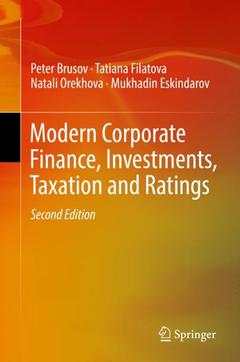Modern Corporate Finance, Investments, Taxation and Ratings (2nd Ed., 2nd ed. 2018)

This monograph is devoted to a modern theory of capital cost and capital structure created by this book?s authors, called the Brusov?Filatova?Orekhova (BFO) theory, and its application to the real economy. BFO theory promises to replace the traditional theory of capital cost and capital structure by Nobel laureates Modigliani and Miller. This new theory in particular, presents a possible explanation to the causes of the recent global financial crisis. The authors of the book describe the general theory of capital cost and capital structure that can be applied to corporations of arbitrary age (or with arbitrary lifetime) and investment projects with arbitrary duration. The authors illustrate their theory with examples from corporate practice and develop investment models that can be applied by companies in their financial operations.
This updated second edition includes new chapters devoted to the application of the BFO theory in ratings, banking and other areas. The authors alsoprovide a new approach to rating methodology highlighting the need for including financial flow discounting, the incorporation of rating parameters (in particular, financial ratios) into the modern theory of capital structure - BFO theory. This book aims to change our understanding of corporate finance, investments, taxation and rating procedures. The authors emphasize that the most used principles of financial management should be changed in accordance to BFO theory.Part I: Corporate Finance.- Introduction.- Capital Structure: Modigliani–Miller Theory.- Modern Theory of Capital Cost and Capital Structure: Brusov-Filatova-Orekhova Theory (BFO Theory).- Bankruptcy of the Famous Tradeoff Theory.- New Mechanism of Formation of the Company Optimal Capital Structure, Different from Suggested by Trade Off Theory.- The Global Causes of Global Financial Crisis.- The Role of Taxing and Leverage in Evaluation of Capital Cost and Capitalization of the Company.- A Qualitatively New Effect in Corporate Finance: Abnormal Dependence of Equity Cost of Company on Leverage.- Inflation in Brusov–Filatova–Orekhova Theory and in Its Perpetuity Limit – Modigliani – Miller Theory.- Part II: Investments.- A Portfolio of Two Securities.- Investment Models with Debt Repayment at the End of the Project and Their Application.- Influence of Debt Financing on the Efficiency of Investment Projects: The Analysis of Efficiency of Investment Projects within the Perpetuity (Modigliani–Miller) Approximation.- The Analysis of the Exploration of Efficiency of Investment Projects of Arbitrary Duration (within Brusov–Filatova–Orekhova Theory).- Investment Models with Uniform Debt Repayment and Their Application.- Part III: Taxation.- It Is Possible to Increase Taxing and Conserve a Good Investment Climate in the Country?- It Is Possible to Increase the Investment Efficiency, Increasing Tax on Profit Rate? An Abnormal Influence of Growth of Tax on Profit Rate on the Efficiency of the Investment.- Optimizing of the Investment Structure of the Telecommunication Sector Company.- The Golden Age of the Company (Three Colors of Company's Time).- A "Golden Age" of the Companies: Conditions of its Existence.- The Role of the Central Bank and Commercial Banks in Creating and Maintaining of a Favorable Investment Climate in the Country.- Part IV: Ratings and rating methodologies.- Rating: New Approach.- Rating Methodology: New Look and New Horizons.- Ratings of the Long–Term Projects: New Approach.- New Meaningful Effects in Modern Capital Structure Theory.- Conclusion.
Petr Nickitovich Brusov is professor at the Financial University under the Government of the Russian Federation (Moscow). Originally a physicist, he was the co-founder of (together with Victor Popov) the theory of collective properties of superfluids and superconductors. In area of finance and economy, Peter Brusov has created a modern theory of capital cost and capital structure, the Brusov- Filatova- Orekhova theory, together with Tatiana Filatova and Natali Orekhova. Peter Brusov has been visiting Professor of Northwestern University (USA), Cornell University (USA), Osaka City University (Japan) among other places. He is the author of over 500 research publications including six monographs, numerous textbooks and articles.
Tatiana Filatova is professor at the Financial University under the Government of the Russian Federation (Moscow). In the last 20 years, she has been a dean of the faculties of financial management, management, state and municipal government among others at the Financial University. Tatiana Filatova is the author of over 250 research publications including five monographs, numerous textbooks and articles.
Natali Orekhova is professor of the Center of Corporate Finance, Investment, Taxation and Rating at the Research Consortium of Universities of the South of Russia. Natali Orekhova has been leading scientist of the Financial University under the Government of the Russian Federation. She is the author of over 100 research publications including three monographs, numerous textbooks and articles.
Mikhail Abdurakhmanovich Eskindarov is professor, honored scholar of the Russian Federation; member of the Russian Academy of Education, and rector of the Financial University under the Government of the Russian Federation (Moscow). Mikhail A. Eskindarov has played crucial administrative, teaching and researcher roles at the Financial University. He is the author of over 200 research publications including
Date de parution : 11-2018
Ouvrage de 571 p.
15.5x23.5 cm



